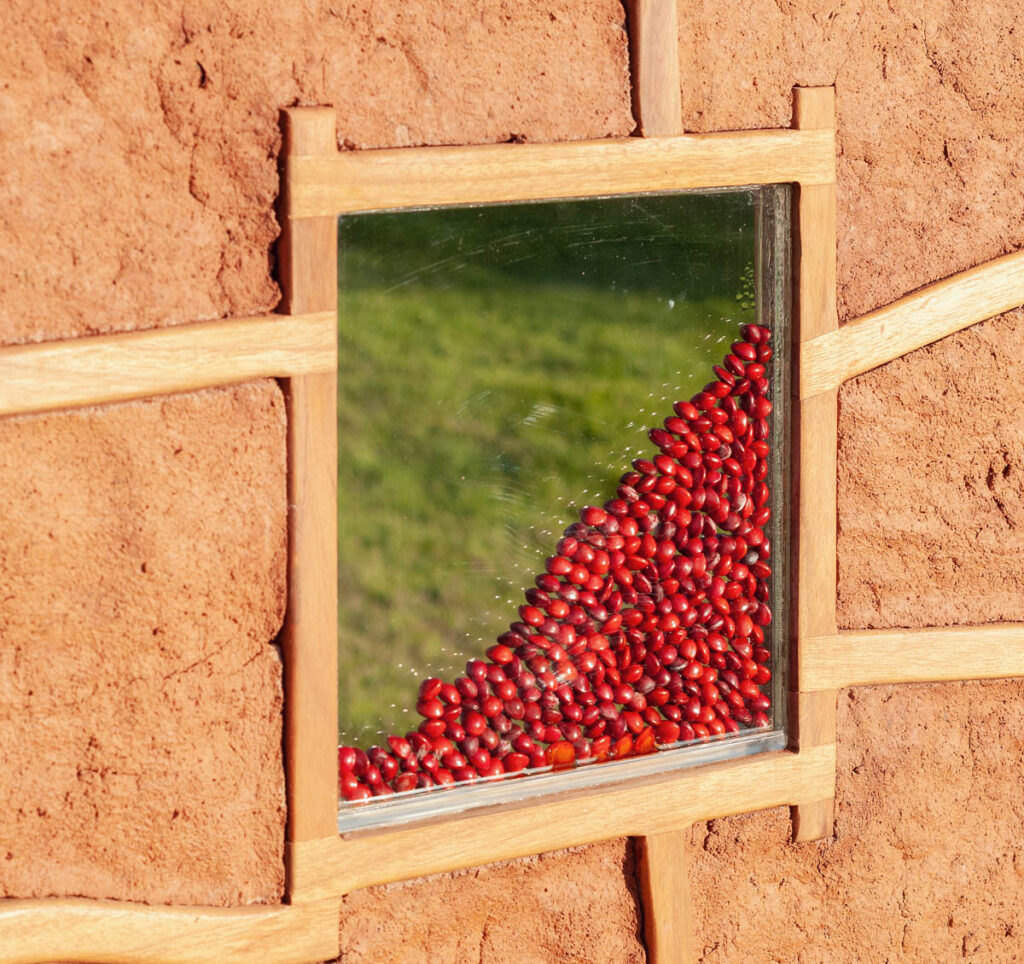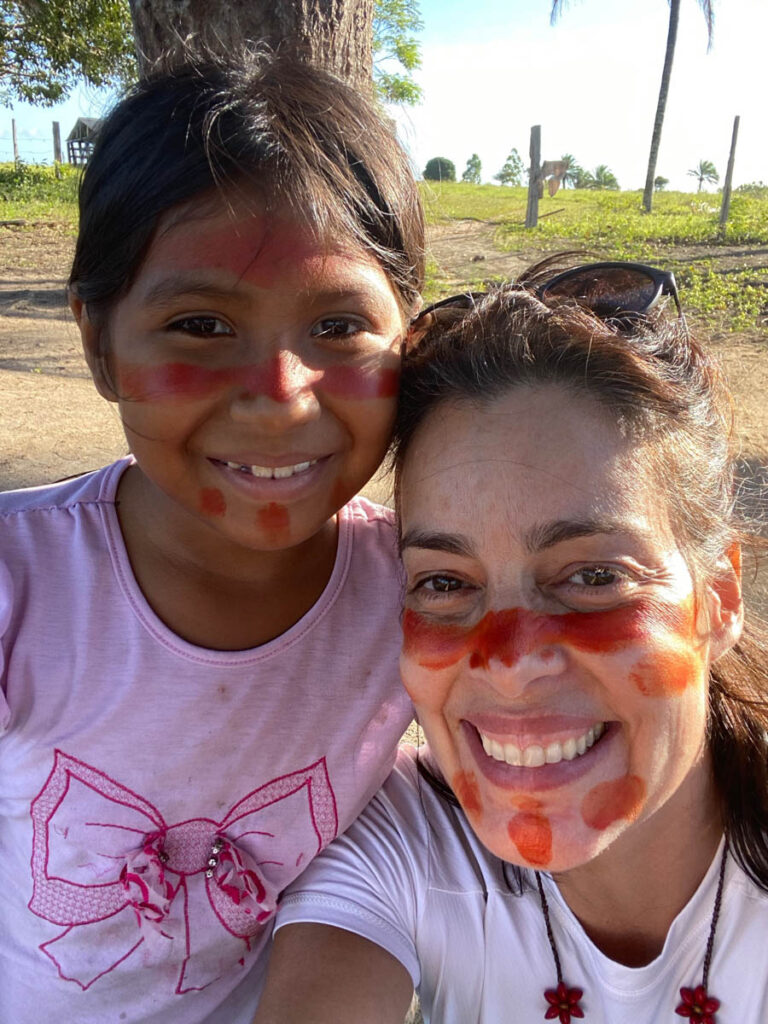
Maria Fernanda Paes de Barros constructs a free-standing wall for a Pataxó village that reflects a hands-on cultural dialogue.
(A message to the reader.)
Pa….. ta….. xooooooó….
The sound of the waves hitting the rocks gave rise to the name of the Pataxó indigenous people. The Pataxós are the ninth most populous people in Brazil with around 23 thousand individuals. They are a people of the forest and the coast. On full moon nights, they perform prosperity rituals at the beach.
Their territory mixes the gentle breeze from the sea, the white sand beaches of southern Bahia, with its tall coconut trees, and the remnants of the Atlantic Forest that so enchanted the Portuguese in the 1500s. Invited by the leader Arassari Pataxó, I enter it listening to the history of Brazil that is not usually told or taught in school books. Along the dirt path, between the heat of the sun and the shade of the trees, small wattle and daub houses with thatch roofs appear. Exposed wooden structures seek to win a fight that began hundreds of years ago.

Even though I knew it wasn’t possible, I tried to feel in my soul what his people had gone through in the past and continue to go through today, this time with the invasion of land grabbers in search of land valued by agriculture and tourism in the region. As an artist, I need this type of immersion to feel that my work is as faithful as possible to all the knowledge that was offered to me. This day I learn that living in a brick house is not an option for them, it is a necessity. When their lands are invaded, fire puts an end to centuries of history in seconds. Living in a concrete house does not mean wanting to become white, it does mean understanding that you have to give up a tradition to keep many others alive.
I spent the night under the starry sky, in a mountaintop village, watching Arassari and his family dance and sing around the fire, with the sound of seed necklaces and belts, the rustling of tupxais (a traditional skirt made with biriba fibers) and the crackle of fire that made the painted skins even redder. The Pataxó people have no written language, just the spoken Patxohã (that means fighter language), so the importance of orality and music as a way of transmitting knowledge is immense. I was sitting on a fallen tree trunk, but I felt like I was not there. I felt like floating, I was light despite the weight of all the knowledge I was absorbing since my arrival. I danced, sang, learned, felt, until the time came to enter the adobe house where a bed protected by a mosquito net made kindly by Arassari’s mother, Alzecira, was waiting for me. I slept, although the sensation was that I was already in a dream.
The next day was also intense, full of new learnings that challenged my understanding, until then only based on one side of the story. As in the first day, the cracked shapes of the houses caught my attention. I’m unsure how to explain it, but when I noticed, my eyes had already moved to a new house that appeared on the horizon. Like magnets that attract each other so quickly that there is no time to take action. Perhaps it was the mixture of fragility and strength that they convey. Its walls gradually come apart, crack, leaving the pores open. In them, are registered the scars of time. In them, I find the marks of history, like the passage of time that takes little layers of us, of our fragile skin that covers our soul and strives to keep our essence safe. It is as if the wickedness of the world marks us but does not change our being.
Maybe the rain will still wash away the many layers that we have, getting rid of the marks of those skins that have accumulated over the years, and bare our souls, so that, free from prejudice, we remain only essence, so that we all understand ourselves as brothers and sisters, children of the earth and responsible for their protection.
A finished work is the result not only of inspiration and creativity, of drawings that are born, take shape and leave the paper to become tangible. A finished work is the result of a lot of research, a construction process (sometimes a reconstruction) and the discoveries we make during it. As I built the work Passagem several other emotions and feelings emerged, understandings that were only possible because I gave myself over to search through my own layers. I put my hand in the clay, experimented, tested, took risks, understood my own limits and those of others.
The work Passagem (Passage in literal translation), created for the exhibition Orgânico in 2021 (São Paulo, SP, Brazil) at the invitation of curator Marc Pottier, is a wall that references everything I’ve experienced, modelled with the clay that I brought with me from the Pataxó lands, in an attempt to bring with it the soul of a people and make the spectator feels this energy when in contact with it.
In the wall, each space created between the wooden structures was filled with this clay. The thin wire mesh that divided them in half, placed there to help with support, was also the delimiter of a space that could only be filled well if I placed a hand on each side and little by little pressed until it was completely occupied. But what about when my arms could no longer reach? The need for others became pressing. It was the hands of my carpenter David who, together with mine, sought to complete the missing spaces. We learned together how far each one could go and how much pressure to apply so that the clay we placed on the different sides came together and stuck to the canvas without breaking apart and shattering on the floor. We not only need to balance the pressure of our fingers, but also synchronize them as in a delicate ballet where the movements complement each other and, if one exceeds the limit, we end up letting the other fall.
There is also a small window in the upper part of the work filled partially with red seeds, from the Tento tree (Adenanthera pavonina), widely used by the Pataxó people to make necklaces and other adornments. The children in the village helped me collect them scattered across the land, letting me bring to São Paulo the future wrapped in their dreams. This window allows us to see beyond, to see what and who is on the other side, to encourage us to always look for the other side of the story so that we can understand it more completely.
Passagem enables us to be on both sides, to feel the passage of time and to rethink our way of being with ourselves and every living being. Seeds symbolize life, they are potential living beings waiting for the moment to come into the world. What world do our attitudes want to leave for the future? We urgently need to learn that life is a constant ballet, we depend on each other and balance between us is essential. We are here just passing through.






